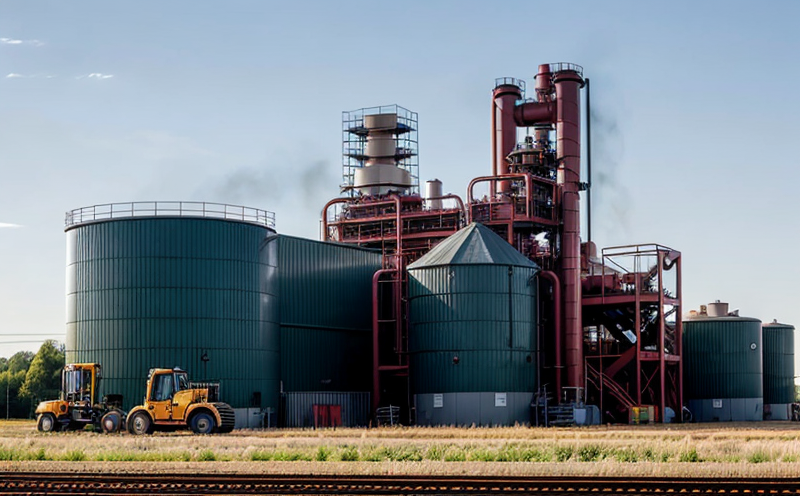ISO 10494 Power Plant Equipment Noise Emission Testing
The ISO 10494 standard is a critical tool in ensuring that power plant equipment operates within acceptable noise emission limits. This test ensures compliance with international standards, which are designed to protect public health and the environment from excessive noise generated by industrial machinery.
Power plants generate high levels of sound due to their massive turbines, compressors, and fans. Excessive noise can lead to hearing damage among workers and disturbance for nearby communities. The ISO 10494 standard provides a framework for measuring these emissions accurately and consistently across different power plant equipment types.
The testing procedure involves placing the equipment under realistic operating conditions in an anechoic chamber, where external noise is minimized. This allows for accurate measurement of the equipment's intrinsic noise levels. The test setup includes sensors that capture sound pressure levels at various angles around the machinery. These data points are then analyzed to determine if they meet the specified limits outlined in ISO 10494.
Compliance with this standard is mandatory for manufacturers and operators of power plant equipment, as it ensures their products do not contribute excessively to ambient noise pollution. This testing process is crucial in maintaining safety standards while also promoting sustainable practices by minimizing environmental impact. By adhering to ISO 10494, organizations can demonstrate their commitment to both worker safety and community well-being.
The methodology used in this type of testing ensures high precision and reliability, making it an essential part of the quality assurance process for power plant equipment. It helps identify potential issues early on during development or production stages, allowing manufacturers to make necessary adjustments before bringing products to market.
ISO 10494 is recognized worldwide as a benchmark for noise emission testing in industrial environments. Its acceptance by regulatory bodies means that compliance with this standard can facilitate smoother international trade and reduce the risk of non-compliance penalties.
In summary, ISO 10494 Power Plant Equipment Noise Emission Testing plays a vital role in safeguarding public health and reducing environmental harm caused by industrial noise pollution. By employing rigorous testing procedures and adhering to internationally recognized standards, this service contributes significantly towards creating safer workplaces and more sustainable industries.
Scope and Methodology
The scope of ISO 10494 Power Plant Equipment Noise Emission Testing encompasses a wide range of equipment used in power plants. This includes turbines, compressors, pumps, fans, and other rotating machinery that generate significant noise during operation.
The testing methodology involves several key steps to ensure accurate measurement of noise emissions:
- Setting up the equipment under realistic operating conditions in an anechoic chamber.
- Placing sensors around the equipment to capture sound pressure levels at various angles.
- Recording data over a specified duration, typically several minutes or longer depending on the type of equipment.
- Analyzing the recorded data using software that compares it against predetermined thresholds set out in ISO 10494.
The results provide detailed information about where and how much noise is being produced by each component. This allows manufacturers to pinpoint sources of excessive noise and address them proactively through design changes or operational adjustments.
It's important to note that while the standard provides clear guidelines, actual implementation may vary based on specific equipment characteristics and operational requirements. Our laboratory uses advanced technology and experienced personnel to conduct these tests efficiently and accurately.
Benefits
The benefits of ISO 10494 Power Plant Equipment Noise Emission Testing extend beyond mere compliance; they encompass improved product quality, enhanced worker safety, reduced environmental impact, increased customer satisfaction, and better brand reputation.
Improved Product Quality: By ensuring that all components meet the stringent noise emission requirements outlined in ISO 10494, manufacturers can produce superior products. These tests help identify potential flaws early on during development stages, allowing for timely corrections before mass production begins.
Enhanced Worker Safety: Excessive noise levels pose serious risks to human health, including hearing loss and stress disorders. By adhering to ISO 10494 standards, manufacturers can significantly reduce these hazards by designing quieter equipment that meets the specified limits. This not only improves working conditions but also helps attract top talent seeking safe environments.
Reduced Environmental Impact: Noise pollution contributes significantly to poor air quality and other environmental concerns. Through rigorous testing according to ISO 10494, industries can minimize their contribution towards such problems. This aligns with broader sustainability goals and demonstrates corporate responsibility.
Increased Customer Satisfaction: Consumers increasingly value eco-friendly products that contribute positively to society. By complying with international standards like ISO 10494, manufacturers differentiate themselves from competitors who fail to meet these expectations. Satisfied customers are more likely to recommend purchasing decisions, leading to greater market share growth.
Better Brand Reputation: Companies that prioritize environmental responsibility often enjoy positive press coverage and public recognition. Adhering to ISO 10494 helps build trust with stakeholders while showcasing commitment to ethical business practices. A strong reputation translates into long-term success and competitiveness within the market.
International Acceptance and Recognition
The ISO 10494 standard enjoys widespread acceptance across numerous countries, making it a globally recognized benchmark for measuring noise emissions from power plant equipment. Its universal applicability ensures consistent results regardless of geographical location or local regulations.
Many regulatory bodies around the world have adopted ISO 10494 as part of their own guidelines for noise control. This harmonization simplifies compliance processes and fosters international collaboration among manufacturers, operators, and regulators alike.
The standard's detailed specifications provide a common language that facilitates clear communication between stakeholders involved in power plant equipment design, manufacturing, installation, commissioning, operation, maintenance, decommissioning, recycling, or disposal. This interoperability enhances efficiency throughout the entire lifecycle of such machinery.
Additionally, adherence to ISO 10494 can help avoid costly penalties associated with non-compliance. Many regions impose strict fines for exceeding permissible noise levels set forth in local laws. Compliance with this international standard offers a safeguard against potential legal issues and financial losses.





